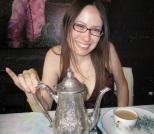What is that elusive concept in writing known as voice? Plot, character, setting, world building, theme: all of these aspects of fiction, while complicated in their own right, are at least fairly simple to explain as basic concepts. But for me, voice has always been trickier to talk about in an intelligent way. I know it when I see it, but what is it that I’m noticing?
First, I’d like to differentiate between authorial voice and narrative voice. By authorial voice, I mean a way of writing that is unique to the author, so that you can read a story by him and know who wrote it by how it is written. Ernest Hemingway has a particularly distinctive authorial voice. So does Herman Melville. By narrative voice, I mean the voice of the protaganists in the story. In first person, this voice completely permeates the text, but even in close third, the descriptions and prose will be affected by whose point of view we are in. (Don’t take these definitions as a golden standard, by the way; the internet disagrees about what these terms mean, so I’m merely sharing my own personal definitions so we can understand each other.)
When we talk about voice in YA, the voice we are usually talking about is narrative voice, not authorial voice. The narrative voice will change from novel to novel and story to story by the same author (except in series). For example, the narrative voice in M.T. Anderson’s Feed is very distinct from the narrative voice in his Octavian Nothing novels.
So what aspects contribute to a specific narrative voice?
1. Vocabulary and word choice, aka diction: What is this character’s likely vocabulary? What words does this character use that may be unique to her world? How much slang is used? How can the choice of words reflect this character’s reality?
2. Range of language: Possibly a subset of word choice. How does this character speak differently to different sets of people? How does this character’s thoughts differ from what he says out loud? Does the range of language change over the course of the story in reaction to external events?
3. World view/perspective and experience: The perspectives of the character reflect themselves in the voice. This includes her backstory, her priorities (look at how obsessed with food Katniss is in The Hunger Games, for example) and views of the world.
4. Psychic distance (a term coined by John Gardner): This refers to the distance the reader is held from the story and is related to POV. In YA, this distance tends to be close and immediate, which is why first person is so popular in the genre.
5. Syntax/sentence length and pacing/density of prose: YA tends to be less densely packed than some adult fiction; to see what I mean, compare Ian McDonald’s Planesrunner (MG, but still a good example) to his adult The Dervish House, or Paolo Bacigaluipi’s Shipbreaker with his adult The Wind-up Girl. Pacing in YA tends to be on the faster side, although there is plenty of adult fiction that is paced just as fast or faster (and there are the occasional slow YAs). Boy books in particular tend towards the fast paced.
6. Maturation of voice over the course of the narrative: Because most YAs are, at least in part, coming of age stories, the voice generally changes as a consequence of maturation and realizations. The change is often subtle.
7. Emotional urgency: YA highlights emotional urgency. Everything is a big deal or the end of the world because the protaganist lacks the experience to see things differently. Speculative YA often literalizes the metaphor and deals with the actual end of the world or life and death situations.
8. Dialogue: The dialogue in fiction directly illustrates the characters’ personalities and way of speaking. It allows us to experience their actual out-loud voice.
9. Interior monologue: This is a critical component of voice in YA. It is used to convey a character’s reactions, emotions, judgments, perspective, and sense of humor. It shows how a character feels about herself as well as the world around her. It allows the readers to understand and feel for the protagonist. (And according to agent Krista Marino, this is the aspect of voice that is most often missing from YA manuscripts that she reads.)
As you can see, voice and character are inextricably linked. In order to be effective, the narrative voice must fit the character, sound like the character, and reveal the character. The better you the writer know the character, the more likely an authentic voice will emerge in your work. (Or conversely, sometimes you may grow to know the character through his voice, depending on how you work.) YA voice in particular is very close to the protagonist(s), very emotionally immediate, and reflects the unique experience of a person in her teens. The voice in YA often changes and matures over the course of the story, and spends time focusing on the internal dialogue of the protagonist as well as the external dialogue.
What did I miss? Please feel free to weigh in.
Further Reading/References:
Perfecting Your YA Voice Part 1, by Ingrid Sundberg
Perfecting Your YA Voice Part 2, by Ingrid Sundberg
Evolving Voice in the Young Adult Novel, by Swati Avasthi
YA vs. Adult: Do You Have the Voice?, by Heather Howland
Narrative Voice and Authorial Voice, by Ruth Nestvold and Jay Lake (This article talks about both narrative and authorial voice, but while I’m a bit unclear as to its actual definitions of the terms, I believe they are different than the definitions I use above.)


